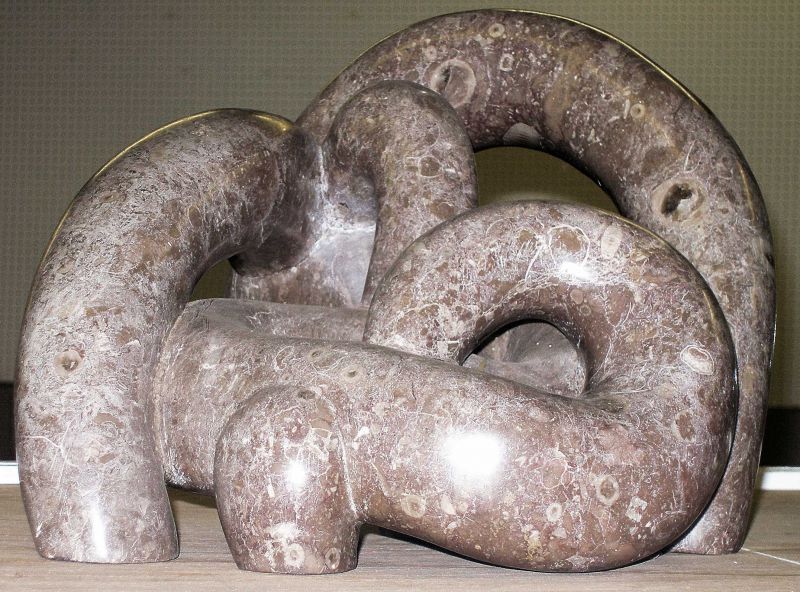| Abstract |
So, what about GEOLOGY? No museum should be without its fossils, and Mersea Museum has a few, although not displayed as such. Some years ago a committee member was able to identify and display a collection of fossilised bones. However, when she left, no-one felt able to take this any further.
Am I being foolhardy in thinking we should make an effort? I don't think so - here goes!

"Horned Lizard" by Richard Bedford
There is one very familiar fossilised artefact which was on show during the last summer season at the museum. It has been much admired, but not for its fossil content. This is the sculpture entitled Horned Lizard, by Richard Perry Bedford. The material from which this was sculpted is a limestone containing orthocones (sometimes referred to as orthoceras), most probably origi ting from Morocco. Orthocones are the cylindrical shapes within the stone. Members of the cephalopod family, these are relatives of the squid and octopus, but most closely related to the utilus. They lived in the Palaeozoic era, during the periods Odovician (490 million years ago), through Silurian and into the Devonian (370 million years ago). When exhibited at mineral shows, this material is usually displayed in the form of bowls, ashtrays, or just as a decorative item. They are highly polished and the fossils are in high relief, making them very prominent.

Mammoth vertebra
The next item was included in our "odd objects" display in the museum last year: the vertebra. There was no indication of its origin, although we knew it had been purchased for the museum by Stewart Baldwin, so I approached him for more information. It is either the first or second vertebra, after the head, of a mammoth. It would have been dredged from the sea which fact is obvious, to the expert, from its colour and weight, but we do not know exactly from where it was dredged.
Mammoths are related to the elephant, and reached their peak during the Pleistocene epoch of the Cenozoic era. They first appeared in Africa, spreading into Europe and Asia before migrating into North America. They were also in Russia and Siberia - you will perhaps remember the frozen baby mammoth being found in Siberia during 2007. The reason for their mass extinction has yet to be agreed, but many experts are of the opinion that mankind was largely to blame, firstly by over-hunting and secondly by re-vamping the landscape, thus breaking up the mammoths' habitat. Other people think the changing temperatures were the cause. Dating the Pleistocene epoch is a little difficult. However, it is generally accepted that the mammoths became extinct as recently as 10,000 years ago.
Another interesting specimen was brought into the museum by a lady who said her husband had found it on the beach in the 'nineties. She had since used it in a garden display, but would like to know more about it. This proved to be the core of a horn, most probably from an aurioch, which was the forerunner of the domestic cow. The aurioch became extinct during the seventeenth century, the last recorded being a female which died in 1627 in the Jaktorow Forest in Poland. It became extinct in Britain during the Bronze Age. 100,000 years ago, during the last interglacial period, the aurioch was roaming the area which is now Trafalgar Square in London. The aurioch is said to have evolved in India some 250,000 years ago, during the Pleistocene period. It was a much larger animal than our modern bovines, standing about 1.75 metres (5ft 9in) as against domesticated cattle at about 1.5 metres (4ft 11in). The museum's aurioch horn has been "tumbled" about in sand and sea. It is very friable and needs some t.l.c. to preserve it. When told of its origin, the lady kindly offered it to the museum. After preservation, it will be another of our exhibits.
Mersea Island has produced many interesting specimens in the past, some referred to in the book "Essex Rock" by Gerald Lucy. The book is sadly now out of print, but I am trying to persuade him to consider a revised edition. In this publication, the author describes the cliff at Cudmore Grove as one of the most important geological sites in Essex as it "provides superb exposures of Thames/Medway gravels laid down during the Hoxnian interglacial stage, when monkeys, bears and early man lived in Essex".
Published as Museum Piece in Mersea Courier 22 January 2011
|